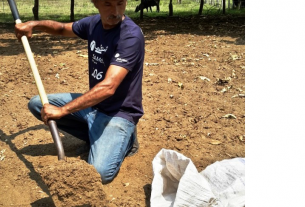By Tommy Clarkson from the May 2018 Edition
Ophiopogon japonicas
Family: Liliaceane
Also known as: Dwarf Lily Turf, Monkey Grass or Snakebeard
Like a somewhat nondescript person that we busily pass, unnoticed, on a bustling, crowded street, we’ve all seen this plant in a variety of locales and applications. Yet, most likely we looked right past it and never gave it a second thought.
This dense, slow-growing perennial plant grows in thick clumps. It is often used in shopping malls, beneath signage in apartment or condo entrances, in garden borders or even, effectively employed in erosion control. Yet other applications are for its incorporation in the moist soil of bog gardens, near water features or alongside streams and dams.
Though the name indicates otherwise, it is actually not a member of the grass family (Poaceae). Accordingly, unlike most grasses, it will not tolerate being trod upon. But as Neil Sperry observed in his book Texas Gardening – It’s “a good choice in narrow spots where you need something that doesn’t sprawl.” He further notes, “It’s especially good under trees,since it has no runners to snag fallen leaves.”
The word Ophiopogon describes its bloom. Translated from Greek, that means “snake with a beard.” Since most of our local serpents are clean shaven and Quetzalcoatl, the Teotihuacan feathered serpent god has not been observed of late, might I suggest that its flora remind me of grape hyacinth flowers?

Originally, from the forests and woodlands of Japan and Korea, it’s a shade lover. Moderately drought and salt tolerant, it is linear-leafed and it is not uncommon for the tips to brown.
These long, slender leaves are sessile (your word for the day) in nature. (This means that they are “stalkless and attached directly at the base”. These are six to fourteen inches (15.24 – 35.60 cm) long and one-sixteenth to one-quarter inch (.16 – .64 cm) wide.
Its white to pale-blue flowers are seldom seen in the hotter tropical realms. As is generally their nature, ours – here in the sub-tropics – are small and (as may be seen in the accompanying picture) appear deeply nestled amid the leaves. Mondo Grass enjoys fertile, moist and well-draining soil. Outside of regular watering, Ophiopogon japonicus requires little more attention.
If you’ve read very much of my botanical work, the following news nugget comes as no surprise. There is a bit of confusion regarding these and several related varieties of Liriopes! For ex-ample, the similarly named Lily Turf (Liriope muscari) is a relative. (But it’s entitled to writings wholly of its own!)

Dwarf Mondo Grass (Ophiopogon japonicas ‘Nanus’) is one-third or less the size of the typical Mondo Grass, often reaching but only two inches (5.08 cm) tall. Interested in its kin? As per the Clemson University Extension Service, the following are various cultivars you might wish to consider as well: ‘Aureovariegatus’, ‘Variegatus’ and ‘Vittatus’ which have longitudinally striped leaves with white or yellow and green stripes; ‘Caeruleus’ has dark green leaves and violet-blue flowers; ‘Kioto’ or Dwarf Mondo Grass grows only to about four inches (10.16 cm) high with small flowers of light lilac to white; ‘Nippon’ is very small with whitish flowers; and, ‘Gyoko Ryu’ is even shorter and more compact than ‘Nippon’. Beyond these, Black Mondo Grass (Ophiopogon planiscapus), which grows to around six inches (15.24 cm) tall, has dark purple leaves that appear almost black.
As we know, there are all manner of rather obscure, yet positive and effective uses of many of Nature’s plants. Now, though this is stated in none of my botanical books, I recount that this may be one of them. The site, Plants for a Future, asserts that “The root [of the Mondo Grass] antitussive, aphrodisiac, expectorant, pectoral, sedative, sialagogue, stomachic and tonic. It is said to have anticancer potential. It is used internally in helping with dry coughs, fevers, thirst, dry constipation, insomnia, anxiety and palpitations. It is also frequently used in poly-herbal treatments of diabetes mellitus. The roots have an anti-bacterial action, inhibiting the growth of Staphylococcus, E. coli, Bacillus subtilis, B. typhi. For these, the roots are harvested in the spring and dried for later use. The plant is antipyretic, antiscrofulatic, antitussive, emollient, expectorant and lowers blood pressure. Nodules on the fibrous roots are used as a nutritive tonic in the treatment of TB.”

Knowing all of this besides the fact that these are wonderful ground cover plants might you want more? Simply carefully dig some up, divide and replant in somewhat sandy, compost soil.
Download the full edition or view it online
—
Tommy Clarkson is a bit of a renaissance man. He’s lived and worked in locales as disparate as the 1.2 square mile island of Kwajalein to war-torn Iraq, from aboard he and Patty’s boat berthed out of Sea Bright, NJ to Thailand, Germany, Hawaii and Viet Nam; He’s taught classes and courses on creative writing and mass communications from the elementary grades to graduate level; He’s spoken to a wide array of meetings, conferences and assemblages on topics as varied as Buddhism, strategic marketing and tropical plants; In the latter category he and Patty’s recently book, “The Civilized Jungle” – written for the lay gardener – has been heralded as “the best tropical plant book in the last ten years”; And, according to Trip Advisor, their spectacular tropical creation – Ola Brisa Gardens – is the “Number One Tour destination in Manzanillo”.




